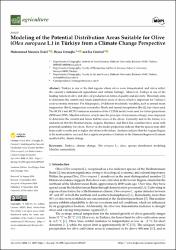| dc.contributor.author | Özdel, Muhammed Mustafa | |
| dc.contributor.author | Ustaoğlu, Beyza | |
| dc.contributor.author | Cürebal, İsa | |
| dc.date.accessioned | 2025-01-13T07:36:24Z | |
| dc.date.available | 2025-01-13T07:36:24Z | |
| dc.date.issued | 2024 | en_US |
| dc.identifier.issn | 2077-0472 | |
| dc.identifier.uri | https://doi.org/10.3390/agriculture14091629 | |
| dc.identifier.uri | https://hdl.handle.net/20.500.12462/15728 | |
| dc.description | Özdel, Muhammed Mustafa (Balikesir Author) | en_US |
| dc.description | Özdel, Muhammed Mustafa (Balikesir Author) | en_US |
| dc.description.abstract | Türkiye is one of the first regions where olives were domesticated, and olives reflect
the country’s millennia-old agricultural and cultural heritage. Moreover, Türkiye is one of the
leading nations in olive and olive oil production in terms of quality and diversity. This study aims
to determine the current and future distribution areas of olives, which is important for Türkiye’s
socio-economic structure. For this purpose, 19 different bioclimatic variables, such as annual mean
temperature (Bio1), temperature seasonality (Bio4), and annual precipitation (Bio12), have been used.
The RCP4.5 and RCP8.5 emission scenarios of the CCSM4 model were used for future projections
(2050 and 2070). MaxEnt software, which uses the principle of maximum entropy, was employed
to determine the current and future habitat areas of the olives. Currently and in the future, it is
understood that the Mediterranean, Aegean, Marmara, and Black Sea coastlines have areas with
potential suitability for olives. However, the model projections indicate that the species may shift
from south to north and to higher elevations in the future. Analyses indicate that the Aegean Region
is the most sensitive area and that a significant portion of habitats in the Marmara Region will remain
unaffected by climate change. | en_US |
| dc.description.abstract | Türkiye is one of the first regions where olives were domesticated, and olives reflect
the country’s millennia-old agricultural and cultural heritage. Moreover, Türkiye is one of the
leading nations in olive and olive oil production in terms of quality and diversity. This study aims
to determine the current and future distribution areas of olives, which is important for Türkiye’s
socio-economic structure. For this purpose, 19 different bioclimatic variables, such as annual mean
temperature (Bio1), temperature seasonality (Bio4), and annual precipitation (Bio12), have been used.
The RCP4.5 and RCP8.5 emission scenarios of the CCSM4 model were used for future projections
(2050 and 2070). MaxEnt software, which uses the principle of maximum entropy, was employed
to determine the current and future habitat areas of the olives. Currently and in the future, it is
understood that the Mediterranean, Aegean, Marmara, and Black Sea coastlines have areas with
potential suitability for olives. However, the model projections indicate that the species may shift
from south to north and to higher elevations in the future. Analyses indicate that the Aegean Region
is the most sensitive area and that a significant portion of habitats in the Marmara Region will remain
unaffected by climate change. | en_US |
| dc.language.iso | eng | en_US |
| dc.publisher | Multidisciplinary Digital Publishing Institute (MDPI) | en_US |
| dc.relation.isversionof | 10.3390/agriculture14091629 | en_US |
| dc.rights | info:eu-repo/semantics/openAccess | en_US |
| dc.rights | info:eu-repo/semantics/openAccess | en_US |
| dc.rights.uri | http://creativecommons.org/licenses/by/3.0/us/ | * |
| dc.subject | Türkiye | en_US |
| dc.subject | Türkiye | en_US |
| dc.subject | Climate Change | en_US |
| dc.subject | Climate Change | en_US |
| dc.subject | Olea Europaea L. | en_US |
| dc.subject | Olea Europaea L. | en_US |
| dc.subject | Olive | en_US |
| dc.subject | Olive | en_US |
| dc.subject | Species Distribution Modeling | en_US |
| dc.subject | Species Distribution Modeling | en_US |
| dc.subject | MaxEnt | en_US |
| dc.subject | MaxEnt | en_US |
| dc.subject | Sustainability | en_US |
| dc.subject | Sustainability | en_US |
| dc.title | Modeling of the potential distribution areas suitable for olive (Olea europaea L.) in Turkiye from a climate change perspective | en_US |
| dc.type | article | en_US |
| dc.relation.journal | Agriculture-Basel | en_US |
| dc.contributor.department | Fen Edebiyat Fakültesi | en_US |
| dc.contributor.authorID | 0000-0003-0715-4566 | en_US |
| dc.contributor.authorID | 0000-0002-9876-3027 | en_US |
| dc.contributor.authorID | 0000-0002-3449-1595 | en_US |
| dc.identifier.volume | 14 | en_US |
| dc.identifier.issue | 9 | en_US |
| dc.identifier.startpage | 1 | en_US |
| dc.identifier.endpage | 18 | en_US |
| dc.relation.publicationcategory | Makale - Uluslararası Hakemli Dergi - Kurum Öğretim Elemanı | en_US |




















